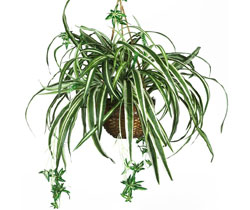Spider Plant (Chlorophytum comosum “Vittatum”)
Buy your own Ocean Spider Plant: Easy to Grow (Cleans the Air) from Amazon.com.
Care:
Semi-sun to semi-shade. Prefers natural light, but do not place in direct sunlight. A few feet from a window should be fine.
To propagate the Spider Plant, remove an airborne plantlet and root in soil or water. If the plant is overwhelmed by its plantlets, feel free to remove them; too many plantlets may be a drain on the parent plant’s energy.
The Spider Plant does not like air that is too dry, and dryness attracts aphids, scale insects and mealybugs. In the rare event that pests do infest your Spider Plant, simply spray a soapy water mixture over the plant and wash the foliage a couple of times a day.
Keep the soil moist but allow to dry slightly between waterings. Feed regularly in spring and summer, but less in the autumn and winter months.
So, water the Spider Plant once every two weeks. If the foliage tips turn black or the foliage shows a yellow halo, the plant is getting too much water. If the foliage begins to drop, the plant needs more water. If the foliage begins to brown, experiment with watering with distilled water — the Spider Plant is sensitive to chemicals in the water.
Plant in all-purpose planting soil or in hydroculture.
From a Spider Houseplant Owner:
“White and green spider plants look lovely in a hanging basket placed in the corner of a shady, protected porch.
To create a waterfall effect, plant a large spider plant in one half of the pot and smaller spider plants in the other half. Cut off any ‘babies’ that grow over the large plant’s side of the pot.
I adjusted the chains on my pot so that it tipped slightly, with the large plant being higher than the smaller plants. When the babies began to grow from the smaller plants, the effect was of a plant waterfall.
I used a wire and coconut husk hanging basket filled fine gravel in the base for drainage and rotting leaves mixed with rich soil sprinkled over and around the roots. The fleshy roots don’t like to sit in water and seem happier with some air pockets in amongst the roots. I give it a cup of water every 10 or so days, taking care to not let the water sit on the leaves.
Every three years, I yank everything out of the pot and cut all of the leaves back to the root cluster. I chop the roots back until the ball is smaller (cutting most of them in half) and then repeat the above process. Each time I do this, the plants grow back more lush than before. Cutting back and re-potting spider plants can solve problems with yellowing or browning leaves, as this improves drainage and promotes new, healthy growth.”
And from another, self-proclaimed “Brown Thumb”:
“I have what I call a brown thumb. I can kill any plant. But, I have had the same spider plant for 27 years. It is one of the all green types and is in about a 10” plastic pot. I am here to say that the plant will absolutely thrive on sheer neglect. I tell people that it is the only plant that I can’t kill.
I only water mine when the soil is almost dry, and rarely give it plant food. But, I am on well water – no chemicals.
I have kept the plant small by splitting and re-potting it NUMEROUS times. They do seem to quickly get root bound and choke. I’ve gotten lots of compliments on how beautiful a plant it is, and give away plants often.
If I’d have kept all of the splittings and shoots, I’d live in a jungle.
When I want shoots to replant or give away, I simply stop watering it until it starts to turn a pale green. Then I soak the plant well (set it in my sink and give it enough water to run through a couple times, and let it drain well). Then water it well for maybe a month – about a glass of water every few days and maybe a little plant food. Then cut back watering to every couple weeks or so.
I pull off the babies and stick them in a glass of water until they have established roots. Then plant.
I believe sending out shoots is a survival mechanism. It thinks it is dying. So when it gets water, it sends out baby shoots to seek out a better place to live.
I even tried to kill one by leaving it out in the Colorado winter. At the last minute, I felt remorse for the poor thing and brought it back inside. I pulled out all of the brown leaves re-potted it, and set it back in my sunny family room. It was green and shot out dozens of shoots and flowers in no time.
My mom has had a striped spider plant for almost as long, but it has never sent out shoots and always looks frail. I keep telling her to stop watering it so much, but she just can’t do it. She waters it well at least once a week. I think over watering seems to do more damage than under watering. But trust me, I am no plant expert.”


